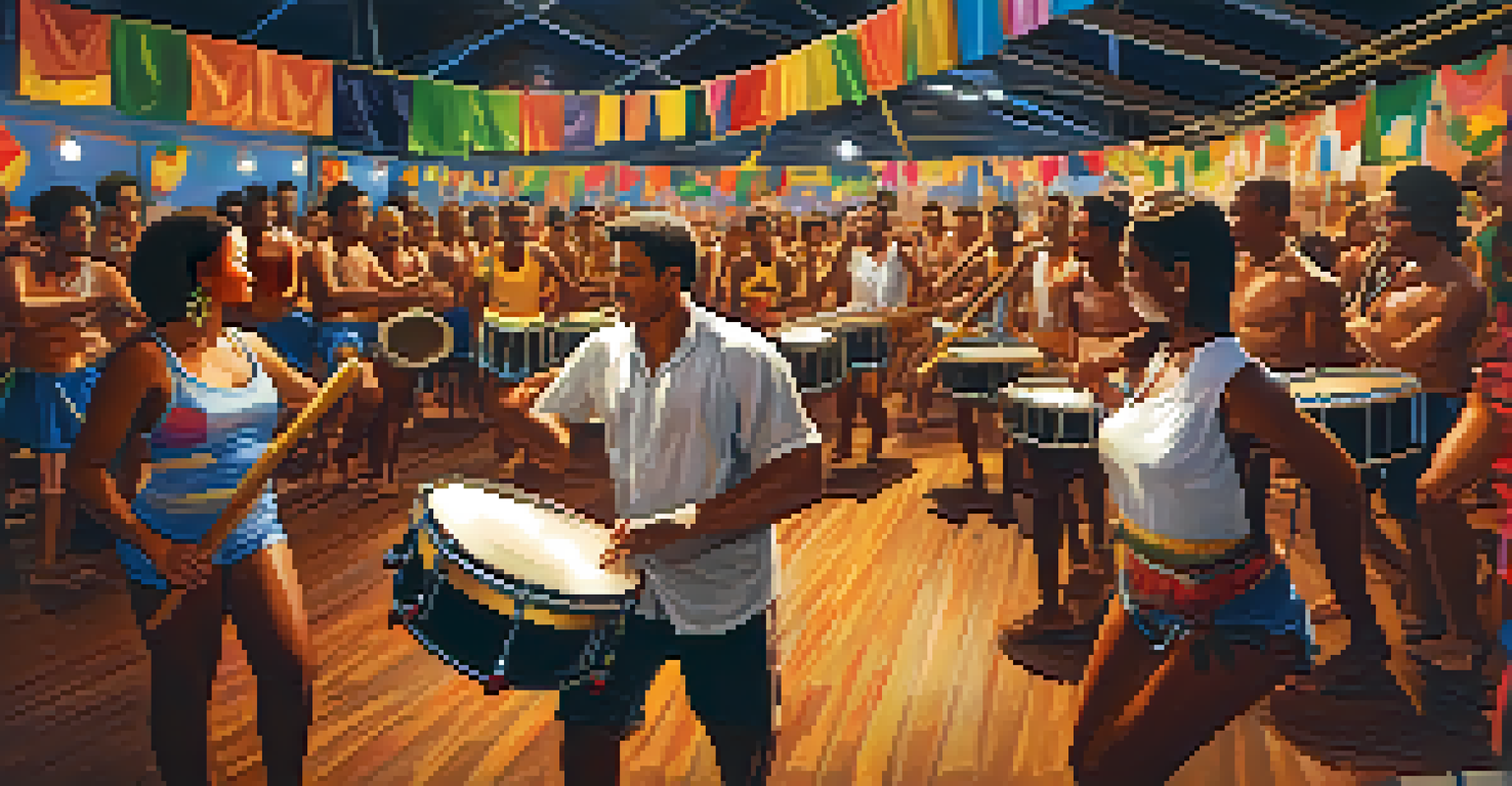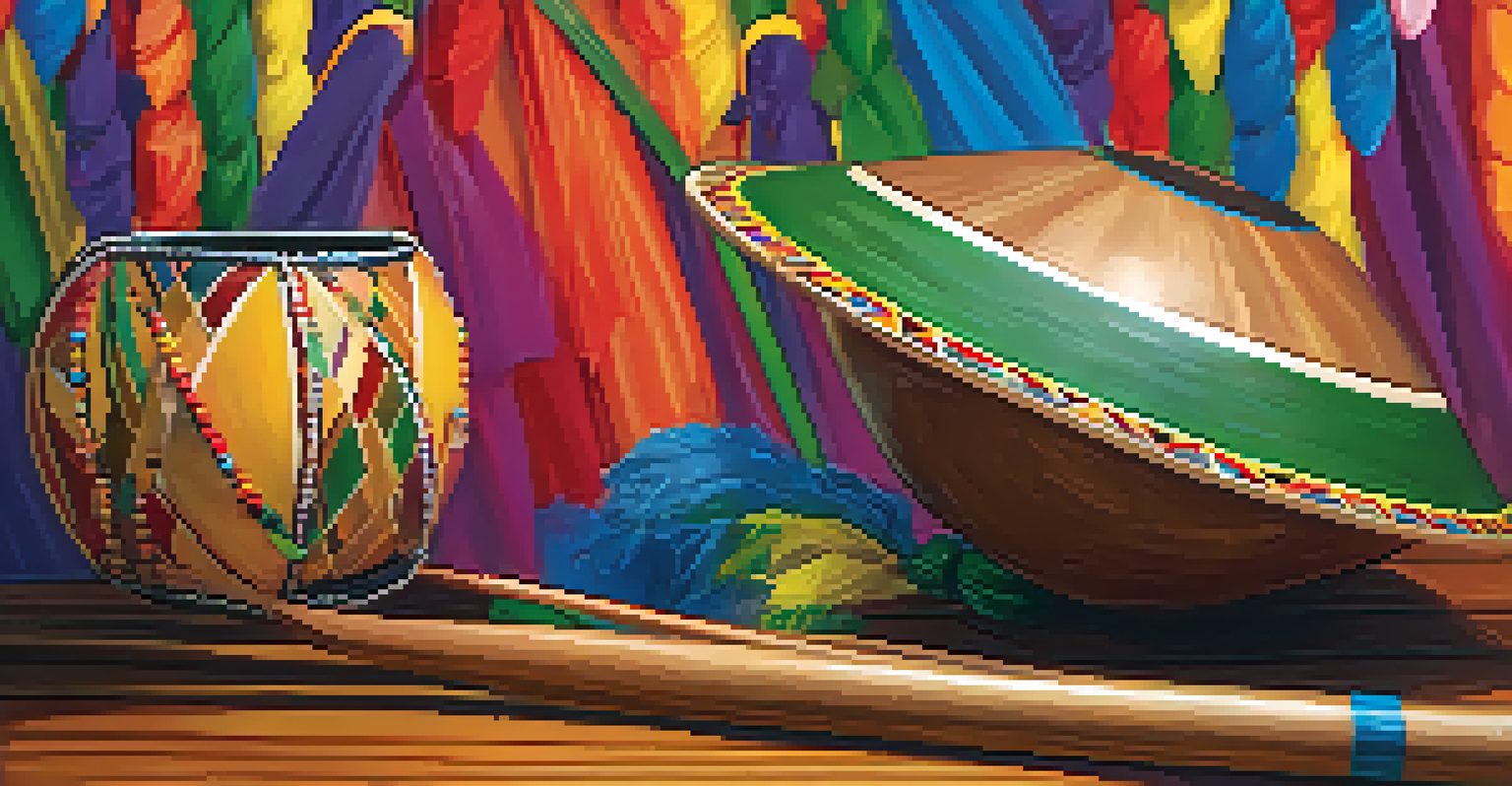Carnaval: How Brazilian Music Shapes This World-Famous Festival

The Origins of Carnaval and Its Musical Roots
Carnaval has deep roots in Brazil, tracing back to colonial times when Portuguese influences blended with African rhythms. This fusion created a unique musical landscape that is integral to the festival's identity. Over the years, various elements, such as samba, frevo, and axé, have emerged, each contributing its own flavor to the celebrations.
Samba is a celebration of life, a joyful expression of the Brazilian soul.
Samba, in particular, is the soul of Carnaval, with its rhythmic beats setting the stage for parades and parties. The infectious energy of samba music invites people to dance, sing, and celebrate together, creating a sense of community. This genre is not just a musical style; it's a representation of Brazilian culture and history.
As Carnaval evolved, it absorbed influences from different regions and cultures, making it a melting pot of sounds and styles. This diversity is reflected in the music played during the festival, showcasing everything from traditional folk tunes to contemporary pop hits. It's this rich musical tapestry that makes Carnaval a truly unique experience.
The Role of Samba Schools in Carnaval
Samba schools are the lifeblood of Carnaval, acting as both performers and educators in the art of samba. Each school is a community hub that brings together people from various backgrounds, united by their passion for music and dance. These schools spend the entire year preparing for the festival, crafting elaborate floats and costumes that reflect their themes.

During Carnaval, samba schools compete in grand parades, showcasing their creativity and talent to thousands of spectators. The music they play is carefully choreographed, with drummers and dancers working in harmony to create a mesmerizing spectacle. This competition is not just about winning; it's a celebration of culture, pride, and community spirit.
Carnaval's Musical Heritage
Carnaval's music is a vibrant fusion of Portuguese and African influences, showcasing the unique rhythms and cultural expressions of Brazil.
The impact of samba schools extends beyond the festival itself, as they play a crucial role in preserving Brazilian musical traditions. They provide training and resources for aspiring musicians and dancers, ensuring that the vibrant spirit of samba continues to thrive. In this way, samba schools are essential for keeping the heart of Carnaval beating strong.
Influence of Brazilian Music on Global Culture
Brazilian music, particularly the sounds of Carnaval, has transcended borders to influence musicians and artists worldwide. The infectious rhythms of samba and bossa nova have inspired countless genres, from jazz to hip-hop. This global reach illustrates the universal appeal of Brazilian music and its ability to bring people together through dance and celebration.
Music is the universal language of mankind.
Artists like Sergio Mendes and Gilberto Gil have introduced the sounds of Brazil to international audiences, blending traditional styles with contemporary influences. Their work has not only popularized Brazilian music but has also fostered collaborations that further enrich the global music scene. This cultural exchange highlights the vibrant tapestry of influences that Carnaval continues to inspire.
The impact of Carnaval's music can also be seen in various festivals around the world, where local artists incorporate Brazilian rhythms into their performances. This cross-pollination of styles fosters creativity and innovation, allowing music to evolve while honoring its roots. As a result, the spirit of Carnaval lives on, influencing new generations of musicians across the globe.
The Spiritual Connection of Music and Dance at Carnaval
At the heart of Carnaval lies a deep spiritual connection between music and dance. For many participants, the festival serves as a form of expression and liberation, allowing them to connect with their cultural heritage. The rhythm of the music often resonates on a personal level, evoking emotions that transcend words.
Dancing at Carnaval is not just about movement; it's a celebration of life and a release of joyful energy. Participants often describe a sense of euphoria when they dance to the vibrant beats of samba, feeling a connection to their ancestors and the community around them. This shared experience fosters bonds among dancers and onlookers alike, creating a sense of unity amidst the festivities.
Samba Schools as Community Pillars
Samba schools are essential to Carnaval, fostering community spirit while preserving and promoting the art of samba through competition and collaboration.
Moreover, the spiritual aspect of Carnaval can be traced back to its roots in African traditions, where music and dance played vital roles in rituals and community gatherings. This legacy continues to thrive today, as many performers honor their heritage through their art. By embracing this connection, Carnaval becomes more than just a festival; it transforms into a powerful expression of identity and culture.
The Evolution of Carnaval Music Over the Decades
Carnaval music has undergone significant transformations over the decades, reflecting the changing dynamics of Brazilian society. From the traditional sounds of samba to the emergence of new genres like axé and pagode, the festival's musical landscape is ever-evolving. These changes often mirror social issues, political movements, and cultural shifts within Brazil.
In the 1980s and 1990s, axé music gained immense popularity, bringing a more upbeat and danceable sound to the festival. This genre combined elements of reggae, rock, and afro-Brazilian rhythms, attracting a younger audience to Carnaval. As a result, the festival expanded its reach, incorporating diverse musical styles and attracting international visitors.
Today, Carnaval continues to embrace innovation while staying true to its roots. Artists experiment with new sounds, blending traditional rhythms with contemporary genres like electronic and funk. This willingness to adapt ensures that Carnaval remains relevant and exciting, captivating both loyal fans and newcomers alike.
The Economic Impact of Carnaval Music
While Carnaval is a celebration of music and culture, it also has a significant economic impact on Brazil. The festival attracts millions of tourists each year, generating substantial revenue for local businesses, hotels, and restaurants. This influx of visitors creates job opportunities and stimulates economic growth, particularly in cities like Rio de Janeiro and Salvador.
The music industry also benefits from Carnaval, as artists and producers capitalize on the heightened interest in Brazilian music during the festival. Many musicians release new tracks or albums leading up to the event, and performances at Carnaval can significantly boost their visibility and career prospects. This symbiotic relationship between the festival and the music industry helps sustain the vibrant culture surrounding Carnaval.
Global Influence of Brazilian Music
The infectious rhythms of Brazilian music from Carnaval have transcended borders, inspiring artists worldwide and fostering cultural exchange.
Furthermore, the economic benefits extend to the samba schools, which rely on sponsorships and ticket sales to fund their elaborate parades. The competition to win the top spot encourages schools to invest in high-quality music and performance, ensuring that the artistry remains at the forefront. In this way, Carnaval not only celebrates music but also serves as a catalyst for economic and cultural growth.
Carnaval's Legacy: Music as a Cultural Treasure
As Carnaval continues to evolve, its music remains a cultural treasure that reflects the diversity and richness of Brazilian society. The sounds of the festival are a testament to the resilience and creativity of its people, celebrating their shared history and dreams. This legacy is passed down through generations, ensuring that the spirit of Carnaval lives on.
The preservation of traditional music styles alongside modern influences is vital for maintaining the authenticity of Carnaval. Efforts to document and teach these musical forms help to safeguard their future, allowing younger generations to connect with their heritage. This commitment to cultural continuity reinforces the importance of music in shaping the identity of Brazilian society.

In conclusion, the music of Carnaval is not just a backdrop for the festivities; it is the very heartbeat of the celebration. It weaves together stories of struggle, joy, and community, making Carnaval an unforgettable experience for all who participate. As we look to the future, it's clear that the music of Carnaval will continue to inspire and unite people around the world.